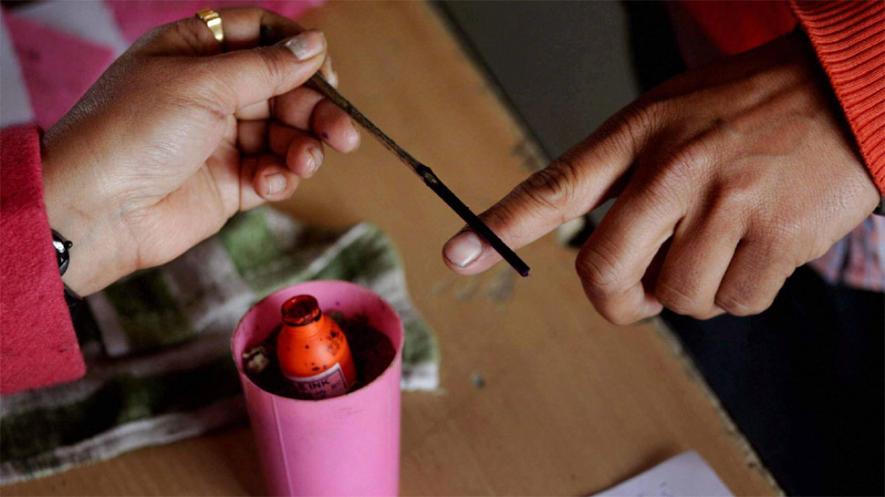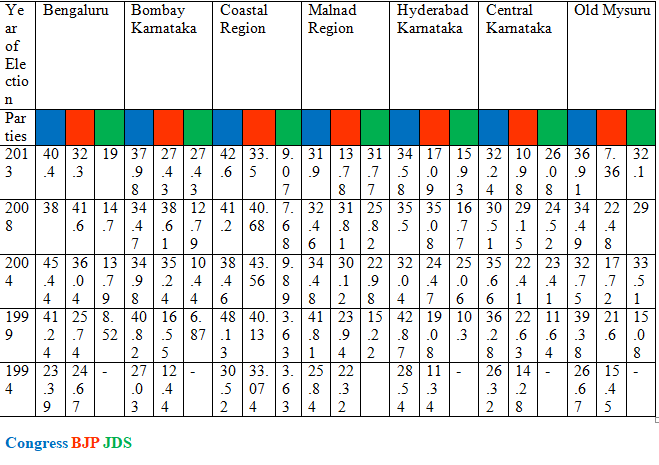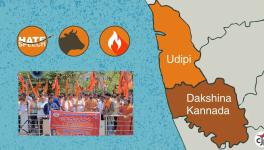Voting Trend in Seven Political Regions in Karnataka From 1994 to 2013

Image Courtesy: Zee News
The southern state of Karnataka is gearing up to witness sixteenth state assembly elections on May 12. The state is divided into seven political regions: Bengaluru region, Bombay Karnataka, Coastal, Malnad, Hyderabad Karnataka, Central Karnataka and Old Mysuru. All the seven regions represent their own unique compositions of caste, religious and linguistics. These compositions act as an influencing factor on the voting patterns in these regions. The New Indian Express has mapped voting trends in these seven regions in last five elections. Based on this data, let us look at and analyse voting patterns that will determine the election outcomes in the state.
In 2006, after breaking the coalition with the Congress, the Janata Dal (Secular) formed a coalition government with the BJP. HD Kumarswamy of JD(S) and B S Yeddyuappa of BJP had formed this government with a pact, according to which, the former was to be the CM for first 20 months, followed by the later. However Kumaraswamy refused to hand over the office to Yeddyurappa. This led to the collapse of the government, resulting into one-month-long president’s rule. On November 12, 2007, Yeddyurappa, after an understanding between the BJP and the JD(S) resumed in the office, but his government lasted for five days – again leading to the president’s rule in the state till 2008. BJP made its political comeback in the state in the 2008 assembly elections and Yeddyurappa was elected as the chief minister. He was forced to resign later, based on the Karnataka Lokayukta report on the infamous Bellary mining scam in 2011 and was succeeded by DV Sadananda Gowda of the BJP.
In the assembly elections of 2013, Siddaramaiah from the Congress was elected as the CM with the Congress government in the state. The state and its people had to wait for seven long years to see a stable government: After SM Krishna, who was the CM from 1999 to 2004, it is the incumbent CM Siddaramaiah and his government, who have managed to complete the full term of five years. From 2004 to 2013, the state saw four chief ministers and the president’ rule twice. It was not the first time, however, that the state has had unstable governments and president’s rule. President’s rule was imposed in the state from March 19, 1971 to March 20, 1972; from December 31, 1977 to February 28; 1978, from April 21, 1989 to November 1989 and from October 10, 1990 to October 17, 1990 for various reasons. Nonetheless, there is a difference between the instability of the governments during these periods and the one from 2004-2013. These periods were preceded and succeeded by successful and stable governments, but between 2004 and 2013, the state was in a state of political and economic chaos with multiple scams and cases of corruptions.
The establishment of a stable government of five years in 2013, in a way, has made the assembly elections of 2018 crucial for the people of Karnataka. The hope is that this political stability will be maintained.
Voting trend in Karnataka from 1994 to 2013
The New Indian Express provides the data of the vote share of Congress, BJP, JD(S), JD/JNP, Independent candidates (IND) and other parties, in all the seven regions, from 1994 to 2013:

Courtesy The New Indian Express
In 1994, the vote share of the Congress was 23.39 per cent in Bengaluru region, and in 2013, it was 40.4 per cent; BJP in 1994 had 24.67 per cent and in 2013, it was 32.3 per cent; JD(S) had no significant presence in 1994 and had 19 per cent of vote share in 2013.
Congress has seen an increase in its vote share in the Bombay Karnataka region. In 1994, it was 27.03 per cent and in 2013, it was 37.98; the vote share of BJP in 1994 was 12.44 and in 2013, it was 27.43. However the vote share of BJP saw a downfall from 38.61 per cent in 2008 to 27.43 per cent in 2013. JD(S) in this region saw a significant increase in its vote share – from 6.87 per cent in 1999 to 27.43 per cent in 2013.
In the coastal region, the Congress, in 1994, had a vote share of 30.52 per cent and in 2013, it was 42.6 per cent; BJP, in 1999, had 33.074 per cent and in 2013, had 33.5 per cent. BJP has had a strong presence in this region. In 1999, the party had vote share of 40.13 per cent. It was 43.56 in 2004, and 40.68 in 2008. However, BJP has seen a dip in the vote share in 2013.
In Malnad region, there was an increase in the vote share of Congress from 25.84 per cent in 1994 to 31.9 in 2013, while BJP was seen having a dip in its vote share. In 1994, it was 22.32 per cent and in 2013, it came down to 13.78 per cent. On the other hand JD(S) was seen performing well in the region. In 1999, the party had just 15.22 per cent vote share and in 2013, it was 31.77 per cent.
Congress has had a stronghold in the Hyderabad Karnataka region and has been consistent in the last five elections. The vote share of the party in the region in 1994 was 28.54 per cent and in 2013, it was 34.58 per cent. The BJP had 11.34 per cent in 1994, and in 2013, it was 17.09 per cent. In 2008 elections, when the BJP won the assembly elections, the vote share of the party had gone up to 35.08 per cent. This increase in the vote share in this region should be noted along with the fact that Bellary is a part of this region. The reason for the resignation of the then CM Yeddyurappa was the infamous Bellary mining scam. Gali Janardhana Reddy, B Sriramulu and Gali Somashekhar Reddy were the accused in the scam, who were from Bellary. Janardhana Reddy was a cabinet minister for tourism and infrastructure. B Sriramulu was the then minister for health and family welfare and tourism, while Somashekhar was the MLA representing Bellary constituency. The data shows that the vote share of the BJP had gone down exponentially in 2013 elections. B Sriramulu and G Somashekhar Reddy, both will be contesting this assembly election.
JD(S) had 10.3 per cent vote share in 1999 and 15.93 per cent in 2013.
In Central Karnataka, the Congress had vote share of 26.32 per cent in 1994, which was was 33.24 per cent in 2013. The sBJP had 14.28 per cent vote share in 1994 and 10.98 per cent in 2013. There is an increase in the vote share of JD(S) from 11.64 per cent in 1999 to 26.08 per cent in 2013.
In Old Mysuru region, both Congress and JD(S) have had a strong hold. The former had a vote share of 26.67 per cent in 1994 and 36.91 per cent in 2013. It was 15.45 per cent in 1994 and 32.1 in 2013. BJP, on the other hand, had 22.48 per cent vote share in 2008 and stooped to 7.36 per cent in 2013.
Making sense of this voting trend
As a report in News18 explains, Bengaluru region accounts for 36 seats in the assembly. In Bangalore urban areas, the BJP and the JDS had been winning. However, the trend has changed from 90s, when Congress started emerging as the winner. In Bangalore rural areas, it is usually is a fight between the Congress and the JDS. According to the report, the rural Bangalore has presence of Vokkaliga community – a dominant caste, and JDS has a strong influence on the community, while Dalits and the economically lower class vote for Congress. The urban middle class in the urban part of the city is the only vote bank that the BJP has in the region.
Bombay Karnataka accounts for 50 seats in the state. The region has a dominant presence of Lingayat community, which has been a vote bank of the BJP. However, the community has been fighting for a minority religion status, and Congress in 2018, by granting the minority status, might have bagged this vote bank from BJP. BJP had been opposing this demand of the community. The Congress has a strong support from the Muslim and Dalit communities in the region as well.
BJP has had a stronghold in the coastal region of Karnataka. According to the report, BJP has its votes divided between the Lingayat and Backward Castes. The Congress has been bagging votes from Dalits, and JDS from the Vokkaliga community. Central Karnataka and Malnad regions have been a gamble for all the three parties.
The Hyderabad-Karnataka region accounts for 31 seats, and has most economically backward regions of the state. As the data explains, BJP does not have a significant presence in the region and the Congress traditionally has a stronghold.
Finally, the old Mysuru region. As the report explains, this region has been a stronghold of both the Congress and the JDS. Muslims and Dalits vote for the Congress and the votes of the dominant community in the region, Vokkaligas go for the JDS.
What awaits in 2018
KP Suresh, an activist and a columnist based in Mysuru noted that the caste and the religion in these regions are not the sole influencing factors. They might or might not directly influence the voting pattern. The data of vote trend in the 2008 elections discussed above, explains Suresh’s concern. BJP has a high number of vote share in six regions except for Old Mysuru region. However, according to Suresh, the reason for this was the sympathy people had for BS Yeddyurappa.
In 2006, HD Kumaraswamy broke the coalition pact with the BJP by refusing to hand over the office to BS Yeddyurappa. This according to Suresh, had garnered sympathy votes for him and the party in 2008 assembly elections. His government that lasted from 2008 till 2011, was not stable and was booked under charges of corruption. There was an extreme dip in the vote share of BJP in 2013 in the coastal region. In 2008, it was 40.68 per cent and in 2013 it was 33.5 per cent.
The fall in the vote share of the BJP in 2013 and the voting trends across the seven political regions in the state make it evident that is a tough fight for the BJP in Karnataka.
Get the latest reports & analysis with people's perspective on Protests, movements & deep analytical videos, discussions of the current affairs in your Telegram app. Subscribe to NewsClick's Telegram channel & get Real-Time updates on stories, as they get published on our website.
























